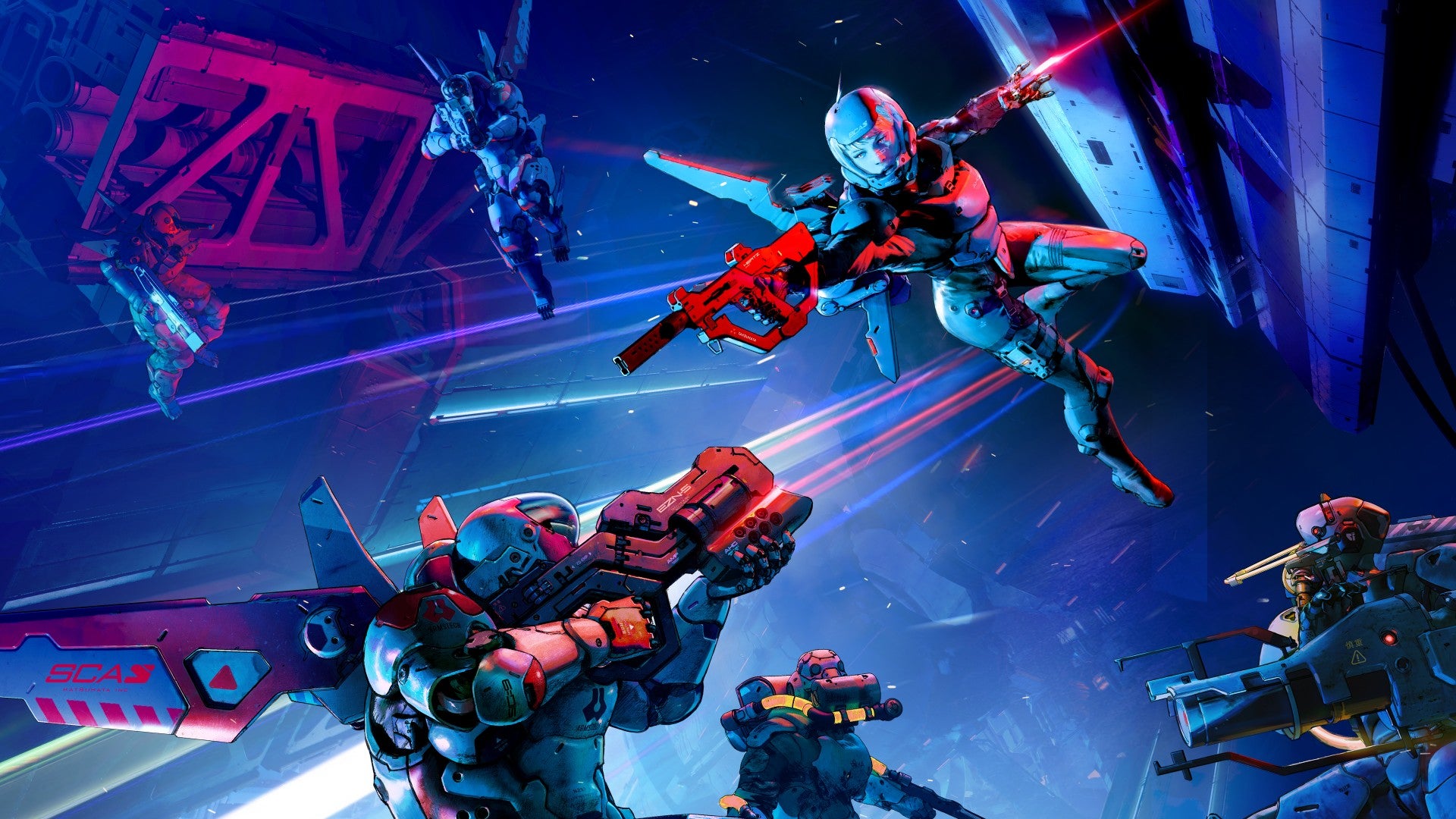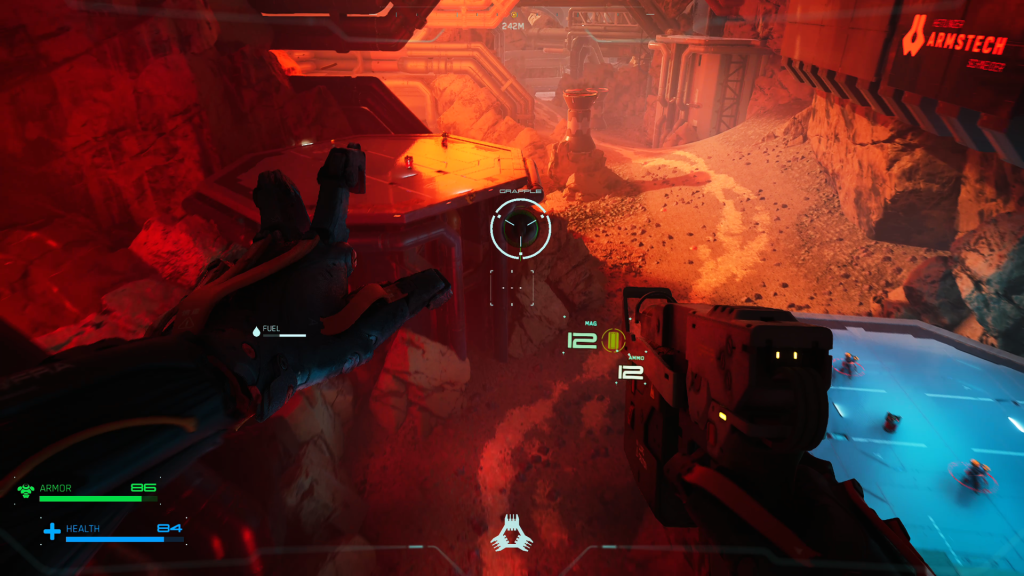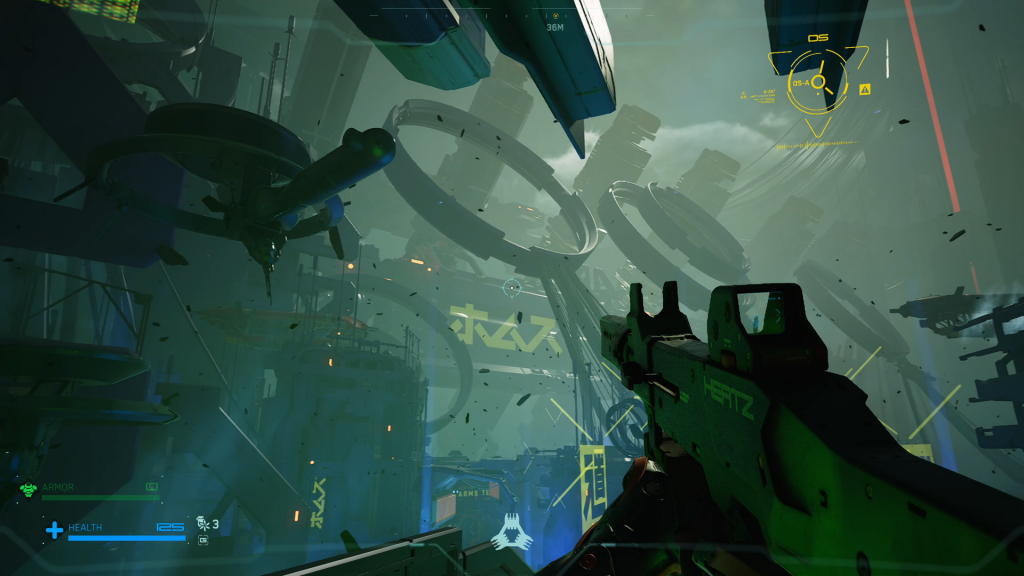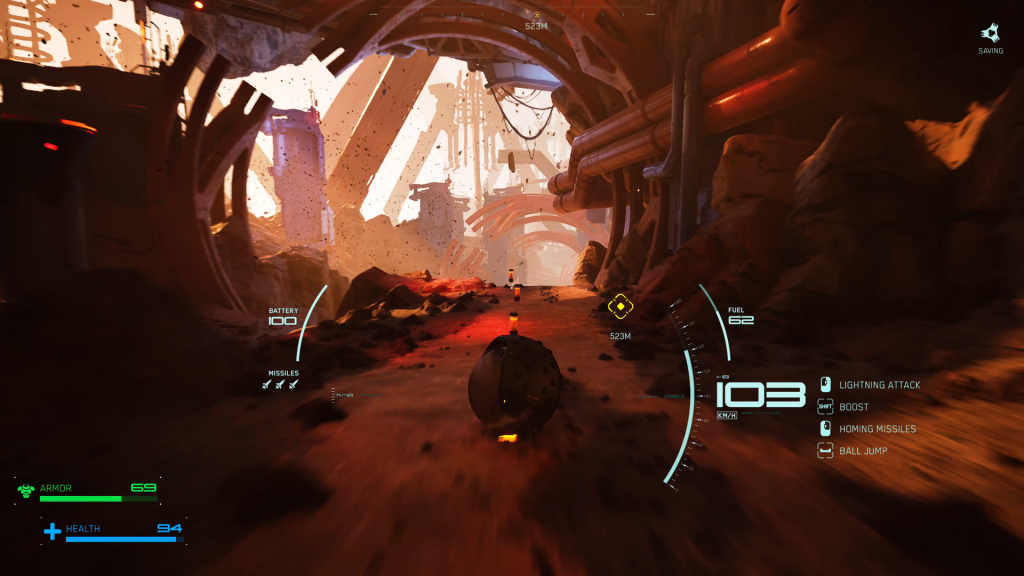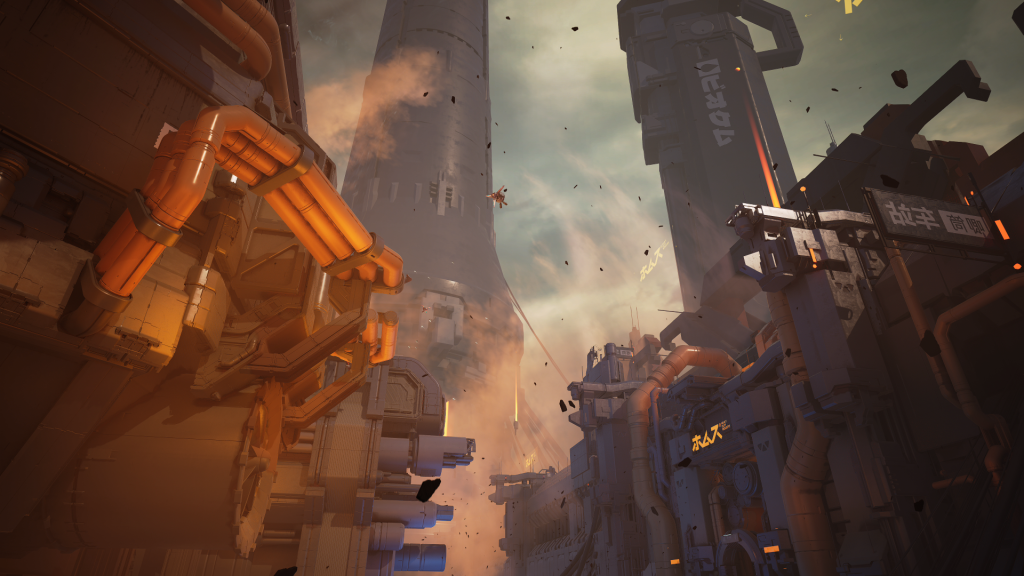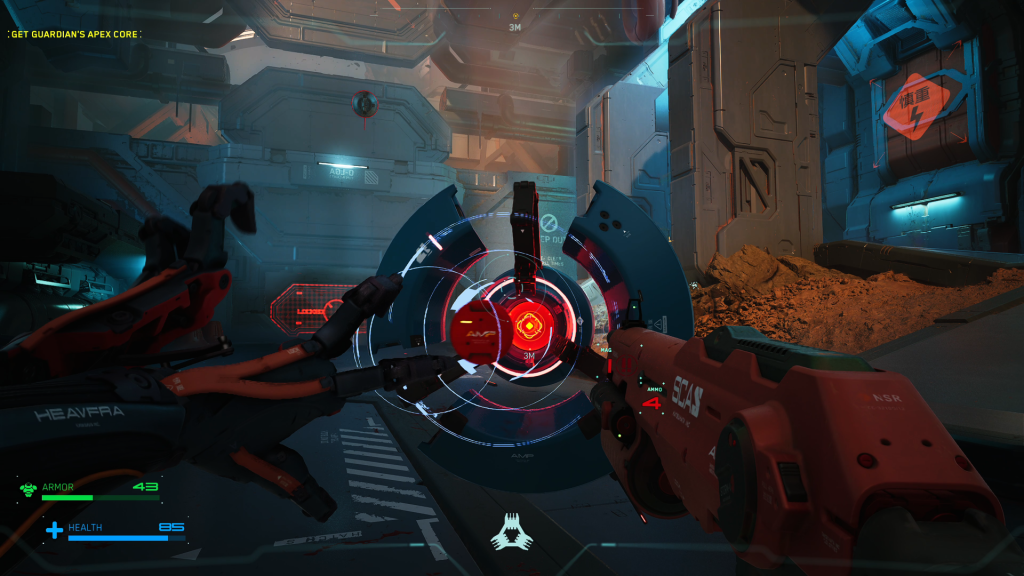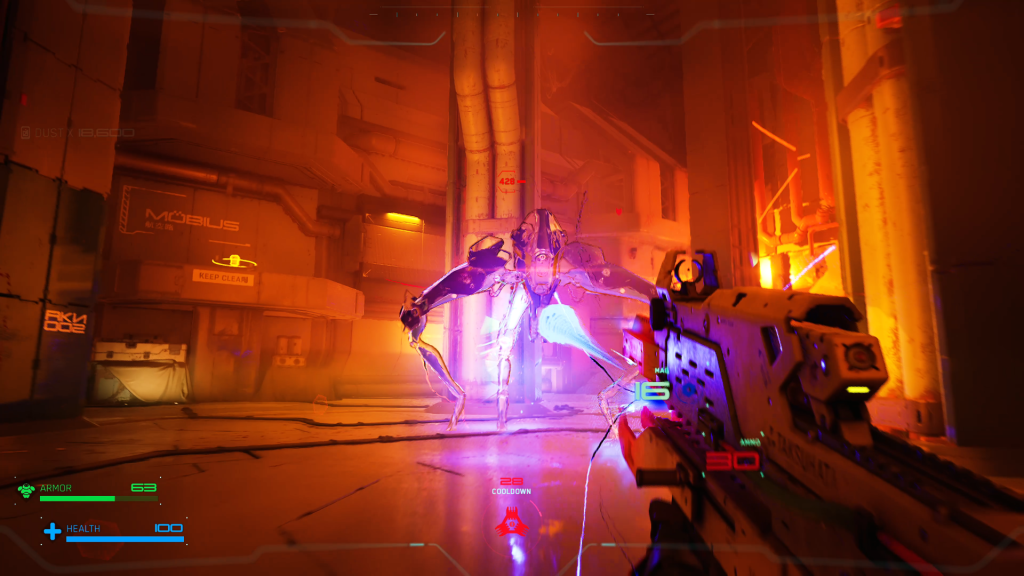METAL EDEN is a fast-paced, sci-fi first-person shooter that has more in common with boomer shooters, yet it looks like a modern shooter with a strong visual style. Reikon Games is back with a game that’s pure, unadulterated velocity. After their previous outing with the brutal and stylish top-down shooter RUINER, the studio has traded the isometric perspective for the full-throttle chaos in this FPS. METAL EDEN is just dripping with style, and is not short on substance to match.
From the moment you step into the armored suit of ASKA, the game establishes its rules: move fast, and don’t stop moving. The city of Moebius, a derelict orbital paradise turned deathtrap, is your playground. The movement mechanics are fluid and intuitive, a potent cocktail of inspiration from titans of the genre. You’ll wall-run like a sci-fi ninja, double-jump and jetpack through vertical arenas like you’re in a forgotten Titanfall sequel, and grapple across vast chasms with the satisfying thwip of a futuristic web-slinger. This suite of abilities is the game’s foundation, and it’s a rock-solid one. The pure act of traversal is a joy, a relentless momentum that carries you from one combat arena to the next.
The combat loop is an intricate dance of aggression and resource management that immediately brings to mind the punchyness of DOOM (2016). The game’s standout mechanic is the “Core Ripping” system. Upon dealing enough damage, you can rip a volatile energy core from a downed foe. This core can be used in one of two ways: consumed to restore health and charge a powerful shield-shattering “Super Punch,” or thrown like a grenade to detonate and wipe out a cluster of enemies. This creates for a frantic risk-reward system, forcing you to constantly evaluate your next move: do I consume a core for my dwindling health, or do I save it for a devastating area-of-effect explosion to finish the fight? The decisions are split-second, the feedback is explosive, and it all works together to create a flow that is nothing short of spectacular.
The arsenal itself is a highlight, with each of the six weapons feeling distinct and impactful. The starting SMG resembles the real-life Vector, and has infinite ammo but it’s caveat is a cooldown that has to occur once all the bullets in the magazine have been expended, it’s always a reliable fallback as new guns are introduced. The shotgun has a satisfying, meat-grinder feel, and the energy lancers are perfect for melting away heavily shielded foes. The way the game constantly introduces new enemy types, forcing you to adapt your strategy on the fly, keeps the combat feeling fresh and challenging throughout its run time. Enemies are agile and relentless, and METAL EDEN demands that you master its systems, punishing you with a swift death if you try to camp or stand still. It’s a design philosophy that respects the player’s intelligence and rewards skill, much like the challenging DNA of Reikon’s previous work, RUINER.
While the weapons are satisfying and impressive on their own, you’ll be collecting a currency called dust that can be used at upgrade stations. Upgrade stations let you enhance each of the weapons you’ve collected. First you can choose one of two alternate fire modes, and then purchase upgrades to each of them. The alternate fire modes can be swapped at these stations, but both cannot be used in combat simultaneously. There’s decisions you need to make, but ultimately can purchase into another upgrade that might suit another need better. Along the way you’ll collect apex cores, these allow you to enhance one of three upgrade trees: the body suit that involve traversal, core ripping efficiency and buffs, and overall core power that makes it so enemies freeze when you punch them. There’s lots of ways to outfit ASKA, and there seems to be no downsides as to how.
After a few levels the game introduces a new way to traverse the world, essentially turning you into Samus Aran from Metroid in ball form. Only, ASKA is a rolling ball of death, able to shoot lightning that can defeat most enemies or shoot a small barrage of missiles. There’s even a boost system that makes it quick and easy to get around. It also helps that ASKA in ball form is impervious to lava. But there are more practical applications too, as being in ball form can charge batteries to open doors.
I’m very much used to be locked into an arena with enemies and eliminating them all, I’m less fond of it when it is in a wave-based format such as this. It does kind of work here, as health, armor, and ammo respawns over time, allowing you to rearm for the next wave. It’s really great when you get to the mission complete screen, as it showcases the amount of time you played that level, how many one-ups were collected, how many kills you had, deaths, cores extracted, and dust collected. There’s no leaderboard or anything, so it feels decidedly old school this way.
The story itself goes a bit too hard in areas, and an NPC that contacts you is often long-winded in his delivery. It’s true that the game’s campaign lasts around six hours across eight missions, albeit it’s a dense and well-paced (outside of the narrative interruptions). So once the credits roll, that’s it. There are no additional modes, no New Game Plus, and no challenge arenas to test your skills outside of the main story. For a game with such a stellar combat system, this feels a little bit like a missed opportunity. The desire to dive back in and master the mechanics is there, but the game gives you no new reasons to do so. The $40 price tag is a steep ask for what is essentially a one-and-done experience, no matter how good this experience is.
What isn’t disappointing is the soundtrack by the venerable composer, Sonic Mayhem. Depending on the level, and where you’re at in it, it can be haunting ambience during its downtime and narrative discovery. Or it can be full of blisteringly beats and dark synths that perfectly compliment that action on-screen. It’s a soundtrack you’ll want to listen to long after the credits roll.
Visually, the game is a feast for the eyes, and in some cases almost retina burning in all the right ways. Moebius is a gorgeous, albeit desolate, cityscape brought to life with the power of Unreal Engine 5. The lighting, particle effects, and reflective surfaces create a stunning cyberpunk aesthetic that feels both futuristic and hauntingly lonely. I was able to get an average of 80fps easily, and it didn’t seem to matter whether software or hardware Lumen was enabled, as it didn’t seem affect performance.
My PC Specs:
– Linux (6.16.4-4-cachyos)
– Intel Core i9 13900K @ 5.8GHz
– ASUS ROG RYUJIN II 360 ARGB AIO Liquid CPU Cooler
– G.SKILL TRIDENT Z5 6000MHZ 64GB (32×2) DDR5 RAM
– ASUS ROG Strix GeForce RTX 4080 16GB GDDR6X
– WD_BLACK SN850X M.2 (4 TB)
– LG UltraGear 34GP950B-G (21:9 Ultrawide @ 3440×1440)
While METAL EDEN isn’t here for a long time, it is here for a good time. The kinetic gameplay and stylish presentation is just enough to justify the price of admission, even if it leaves you wishing for more content and a better-paced story. This game is stylish as hell, and is not to be overlooked, it’s an instant classic. METAL EDEN is stylish as hell, nailing its core mechanics with surgical precision to rip & sear.
A Steam code was provided by the publisher for review purposes
